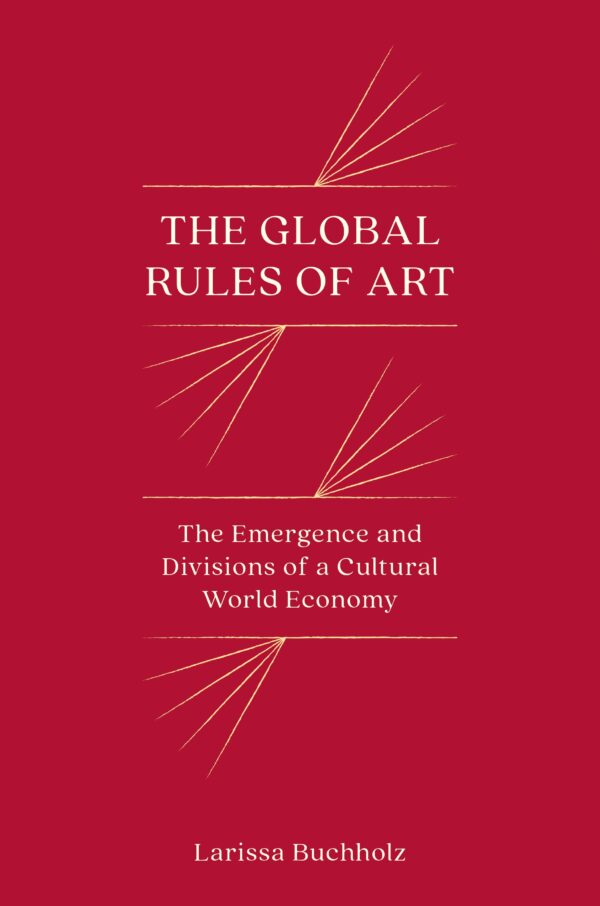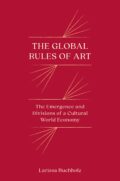
Title
Cosmopolitan Dreams, Peripheral Realities Globalization and Eastern European Art after 1989 – A Review of Larissa Buchholz’s ”The Global Rules of Art”
https://doi.org/10.48285/ASPWAW.29564158.MCE.2024.10.12
https://miejsce.asp.waw.pl/en/cosmopolitan-dreams-peripheral-realities/
DOI
How does globalization reshape artistic production worldwide? In The Global Rules of Art: The Emergence and Divisions of a Cultural World Economy (Princeton University Press, 2022), Larissa Buchholz tackles this question by moving beyond both the optimistic view that globalization equalizes artistic opportunities and the shallow perspective that it merely homogenizes artistic production (the so-called McDonaldization thesis). Drawing on the sociological framework of Pierre Bourdieu, she offers a fresh account of the complex and uneven dynamics shaping the global art world(s) in the late 20th and 21st centuries.
This review has a twofold objective. First, it will summarize Buchholz’s key arguments. Second, it will consider how the book can contribute to understanding the contemporary history of art in Eastern Europe. As I will argue, her framework challenges multiple foundations on the art history of post-socialism and may serve as a source of inspiration to rebuild it in a way that both places the region within the broader transformations of the global art system and does not shy away from the touches of the social reality.
“The bourgeoisie has, through its exploitation of the world market, given a cosmopolitan character to production and consumption in every country,” wrote Marx and Engels in The Communist Manifesto (1848). While Larissa Buchholz cites a different line from the same text, her project investigates a closely related phenomenon. She traces how art production and consumption have become increasingly globalized in recent decades. Rather than taking the global nature of art for granted, her book asks how the global field has developed and what rules govern it today. One of the book’s central strengths lies in its contrast with much of the literature on art and globalization, which often relies on the author’s personal impressions or grand theoretical speculations. Buchholz, by contrast, offers a methodologically rigorous analysis grounded in empirical research, including the use of quantitative methods that are rare but commendable in this field.
For this project, she reaches back to Pierre Bourdieu’s sociology of art, as even the title of the book (The Global Rules of Art) echoes Bourdieu’s book three decades earlier (The Rules of Art, 1992). However, while Bourdieu examined how French literature evolved into an autonomous field in the late 19th century (structured by its own rules and linked to the capitalist modes of production), Buchholz suggests that this theory could and should be upscaled to a global level, as today a significant part of the arts is produced and consumed in that scale.
Continuing the legacy of Bourdieu, Buchholz seeks to move beyond traditional notions of aesthetics. As she states: “Rather than engaging in aesthetic judgement or valuation, I step back to understand the broader historical-institutional context in which valuations take shape, and how they play out.” (p. 3) This does not imply a denial of the fact that many people genuinely believe in concepts such as “beauty,” “kitsch,” or “the sublime.” Rather, this perspective – though potentially unsettling to art and culture professionals – opens up a path toward understanding the social roots of aesthetic value judgments. Buchholz aligns herself with Bourdieu not only in reintegrating art and aesthetics into the social domain but also in exploring their logics. Besides opposing the separation of art and the social domain, she also firmly opposes purely economic explanations (that would say that art does not do anything besides maintaining the authority of the ruling classes), arguing instead that art constitutes a distinct subfield of the social world, governed by its own semi-autonomous logic.
The book aims to contribute not only to questions of art but also to broader debates on globalization and its cultural implications by centering the global operations of the art field. Theoretically, it engages with three influential threads of scholarship on culture and globalization. The first is Herbert Schiller, who, beginning in the late 1960s, conceptualized cultural imperialism by linking the global spread of U.S. cultural products to the hegemonic ambitions of the 20th-century United States. While Buchholz critiques Schiller for being overly economically deterministic, she also engages critically with Arjun Appadurai’s theories of global flows and networks, which she argues largely overlook the role of power. Finally, she examines scholarship on global culture and global art worlds (often inspired by Howard Becker and hallmarked by authors such as Diane Crane), identifying a key blind spot: the failure to recognize the differences obscured by broad labels such as “contemporary art.”

Larissa Buchholz, The Global Rules of Art: The Emergence and Divisions of a Cultural World Economy, Princeton University Press, 2022
Buchholz carves out her theoretical position at the intersection of historical and sociological analysis, offering one predominantly historical and one primarily sociological contribution. Historically, she reconstructs the emergence of the global art field. While the globalization of art has a long history, she argues that the process beginning in the 1980s represents a novel phase. In this era, compared to the model of internationally circulating art that had existed for centuries, the notion of art as globally produced and consumed began to take shape in the imaginations of key actors. This globalization opened up new, though limited, space for the recognition of artists beyond the white Western male canon. More importantly, Buchholz emphasizes that not only artists but also art institutions became global. This process includes the worldwide expansion of auction houses like Sotheby’s and Christie’s, as well as the rise of museum franchises such as the Louvre and the Guggenheim. However, this expansion went beyond the scale of infrastructure and also created a global imagination and discourse surrounding contemporary art. She claims that the challenge to the Western vision of contemporary art (fueled by postcolonial critique) was a key factor in the development of a global art field, and that in this process, the mushrooming biennials from the peripheries were key vehicles. At the same time, as the book warns, we should not separate the globalization of biennials from the global expansion of the art markets since the 1980s.
Bringing together two sides of the same coin – the globalization of the art-market-centered autonomous and the biennial-centered heteronomous – is one of the book’s key insights. These two concepts do not refer to aesthetic qualities (in contrast to much of art theory, which has traditionally praised autonomous art as independent from power structures); rather, they describe different models of social integration. “Autonomous” art is consecrated by experts such as critics and curators, while “heteronomous” art is legitimized by market forces such as art fairs and for-profit galleries. This distinction is reflected in the book’s subtitle, which refers to the “divisions of a cultural world economy.” Central to the argument is the way Buchholz foregrounds the internal tensions and division of labor within art production. Borrowing the terms “autonomous” and “heteronomous” from Bourdieu, she offers an atypical comparison – not between geographic spaces or historical periods, but between the two structural poles of the global art field.
The volume argues that this dual structure offers fundamentally different career paths for artists. Therefore, instead of imagining the hierarchies of the global art world as a single pyramid, we should recognize that two distinct logics – and a dual-pyramid structure – shape contemporary art. This dual structure has multiple consequences, ranging from the oligopolistic nature of mega-galleries to an aesthetic division between often ephemeral, experimental art practices and marketable, painting-led art. In the next part of this review, I will focus on how Buchholz’s understanding of global art as a pair of hierarchical pyramids can offer new perspectives for the art history of Eastern Europe.
While this book is not about Eastern Europe – and the region is not explicitly discussed in the volume, which is understandable given its global ambition and scope – it is nevertheless present in the project’s genealogy. As outlined in the introduction, Buchholz’s perspective was heavily influenced by her personal trajectory – growing up in East Germany and being socialized into the Berlin art world of the early 2000s, when values such as multiculturalism were just beginning to gain prominence and bring a handful of artists and intellectuals from the peripheries into the center of contemporary art discourses. Besides Buchholz’s personal trajectory, her doctoral project – on which the book is based – was advised by Gil Eyal, a sociologist with a deep and sustained engagement with Eastern Europe (see: Eyal, Szelényi, and Townsley 1998; Eyal 2000; Bockman and Eyal 2002).
But what does the volume offer to the art history of Eastern Europe, especially in the post-socialist period? In what follows, I will highlight four ways in which Buchholz’s work can facilitate the rethinking of the recent art and cultural histories of the region. First – and most importantly for those interested in historical research – it enables the debunking of certain myths about the supposed uniqueness of the post-socialist condition. Instead of approaching the global recognition of a handful of Eastern European artists after 1989 – through exhibitions in prestigious venues, entry into major museum collections, and skyrocketing prices – as a liberation from the ”velvet prison” of the socialist art system and an integration into a pre-existing global art field, Buchholz’s book offers a different perspective. It helps us understand that this global field was not already in place, but rather was being constructed during this period. This emerging field – one that welcomed a few but excluded most artists from former socialist countries – was only beginning to take shape around 1989. In this vein, the book’s insights help avoid the pitfall of viewing the global art field as a static entity, with all the dynamism located solely in the integration of post-socialist artists. Methodologically, it invites scholars working on post-socialist art to develop an approach in which global and local scales are in constant flux and mutually – though unevenly – shape one another. Such an approach need not be invented from scratch; it has already been proposed by social historians such as Immanuel Wallerstein (2000) and Philip McMichael (1990), though it has been less frequently applied in studies of the arts. Hopefully, Buchholz’s book can serve as a catalyst for this shift.
Second, the insight that the global art field only began to take shape in the 1980s can also reshape how we understand the infrastructure of socialist art systems. While this period lies outside Buchholz’s primary focus, her work encourages us to unlearn the rigid binary between “Western” profit-oriented and “Eastern” socialist art systems. Rather than exclusively contrasting the art systems of Eastern and Western Europe during the 1945–1989 period, Buchholz’s insights point toward a more comparative direction, highlighting structural similarities between Eastern and Western welfare regimes for artists. Both provided generous state subsidies, including access to studios and state purchases, which helped ease market pressures on many artists.
Similar claims have been made in other disciplines, such as urban studies, where Bodnár (2001) noted that “the Grands Ensembles of Paris look very much like an average housing estate in east-central Europe from the 1970s.” However, such parallels are rarely drawn in studies of art. Of course, acknowledging the similarities in the welfarist management of the arts in socialist and West European countries should not lead us to ignore their differences. Rather, we should remember that these welfare measures – often recalled with nostalgia – were never universal, but instead characteristic of a relatively narrow part of the globe.
Third, the volume offers an important insight into the spatial division of autonomous and heteronomous art-making. While both types of art production are present in virtually every locality, from a global perspective, heteronomous art tends to flourish where capital is concentrated. As Buchholz puts it, the penetration of art fairs correlates with the number of billionaires. This insight helps explain why artists from the peripheries almost exclusively pursue the “autonomous” path to consecration when aiming for global recognition. In fact, this dynamic could be translated – somewhat sarcastically – into a realistic career guide for emerging artists in the peripheries. Inglis (2023) did just this in his review of the book, where he argued that those who come from the peripheries of the global art field with high cultural capital have a chance to be successful in the global art world, but only on its autonomous pole; while those without such capitals can only hope to succeed in the “heteronomous spaces of art-for-money’s-sake”. This review also does an important thing: it starts to integrate the concept of class into the picture, as Buchholtz’s book is mostly concerned with the global spatial structures and divisions of the art world, but less with the global class structures.
Fourth, Buchholz’s book can also serve as an important backdrop for understanding the growing backlash against globalization among artists today – at a moment when we are witnessing the right-wing radicalization of an increasing number of artists and intellectuals. Buchholz’s emphasis on how only a small segment of artists from the semi-peripheries, such as Eastern Europe, have successfully integrated into the globalizing art field helps explain the growing backlash among the broader mass of local artists. For many, globalization has brought a sharp decline in both symbolic recognition (as global star artists and curators became the benchmark even for local professionals) and material standing. Buchholz’s argument resonates with my own findings (Nagy 2023) on the increasing number of artists who, unable to access the global circuits of art and capital, develop anti-Western sentiments and align themselves with local national-capitalist projects that promise protection from the globalization of cultural goods. While Buchholz does not directly examine these processes – doing so would have overstretched the scope of her book – her work still offers important insights. Her analysis of the uneven nature of artistic globalization provides valuable context for those who want to move beyond the success stories of the global art world. It also encourages consideration of the more troubling dynamics that are often overlooked by researchers captivated by aesthetic ideals.
In conclusion, Buchholz’s book stands not only as a cornerstone of a new sociology of art – one that extends Bourdieu’s materialist framework to a global scale – but also as a potential bridge between academic sociology and the professional art world. It deserves to be essential reading for art professionals, encouraging them to reconsider the sociology of art not as a disowned stepchild, but as a vital tool for understanding their own field. Rather than treating sociology as a rule-breaker that smuggles the mundane into the consecrated world of art, the volume shows how material conditions and aesthetic values are deeply interwoven. The book also functions as excellent teaching material for students in the social sciences, arts, and humanities. In an era when undergraduates are more likely to recognize Damien Hirst than Émile Zola, it provides an accessible and compelling introduction to the sociology of art. Finally, the book may broaden the horizons of researchers of Eastern European art – not only by advocating a sociological approach to the material constraints and conditions of art-making, but also by showing that such an approach does not diminish art. Instead, it offers a more grounded understanding of how art operates. Moreover, the book expands the analytical lens by emphasizing that researchers must consider not only local, but also global conditions. This kind of analytical tradition is both much needed and already beginning to take shape. Buchholz’s work can serve as both an inspiration and a provocation for those contributing to this intellectual project.
Bibliography
Bockman, Johanna and Gil Eyal. “Eastern Europe as a Laboratory for Economic Knowledge.” American Journal of Sociology 108, no. 2 (2002):310–352.
Bodnár, Judit. Fin de Millénaire Budapest: Metamorphoses of Urban Life. Minneapolis: University of Minnesota, 2001.
Bourdieu, Pierre. The Rules of Art: Genesis and Structure of the Literary Field. Stanford University Press, 1996.
Eyal, Gil. “Anti-politics and the Spirit of Capitalism: Dissidents, Monetarists, and the Czech Transition to Capitalism”. Theory and Society 29, no. 1 (2000): 49–92.
Gil Eyal, Ivan Szelenyi, Eleanor R Townsley. Making Capitalism Without Capitalists: Class Formation and Elite Struggles in Post-communist Central Europe. London: Verso, 1998.
Inglis, David. “The Global Rules of Art: The Emergence and Divisions of a Cultural World Economy.” Contemporary Sociology 53, no. 1 (2023):30–32.
Nagy, Kristóf. “Hegemony in Action: Crafting New Common Sense at Orbán’s Hungarian Academy of Arts (2011–2023).” Partecipazione e Conflitto 17, no. 4 (2024).
Philip McMichael. 1990. “Incorporating Comparison within a World-Historical Perspective: An Alternative Comparative Method.” American Sociological Review 55, no. 3 (1990): 385–397.
Wallerstein, Immanuel. “World-Systems Analysis.” The Essential Wallerstein, 129–48. New York: The New Press, 2000.
Kristóf Nagy
Kristóf Nagy is a historical anthropologist and sociologist specializing in the cultural politics of contemporary far-right governments. With a background in art history from the Courtauld Institute of Art and a Ph.D. in social sciences from Central European University, his research explores the intersections of imperialism, cultural infrastructures and far-right culture wars through ethnographic and historical methods. He is affiliated with the Central European Research Institute for Art History and the Eötvös Loránd University and is a member of the Working Group for Public Sociology “Helyzet”. For seven years, he has edited Fordulat, a journal of left social theory. In the 2025–2026 academic year, he will be a Fung Global Fellow at Princeton, where he will work on his first monograph examining far-right cultural policies and their global historical connections, with a focus on Hungary as a laboratory for contemporary culture wars.












